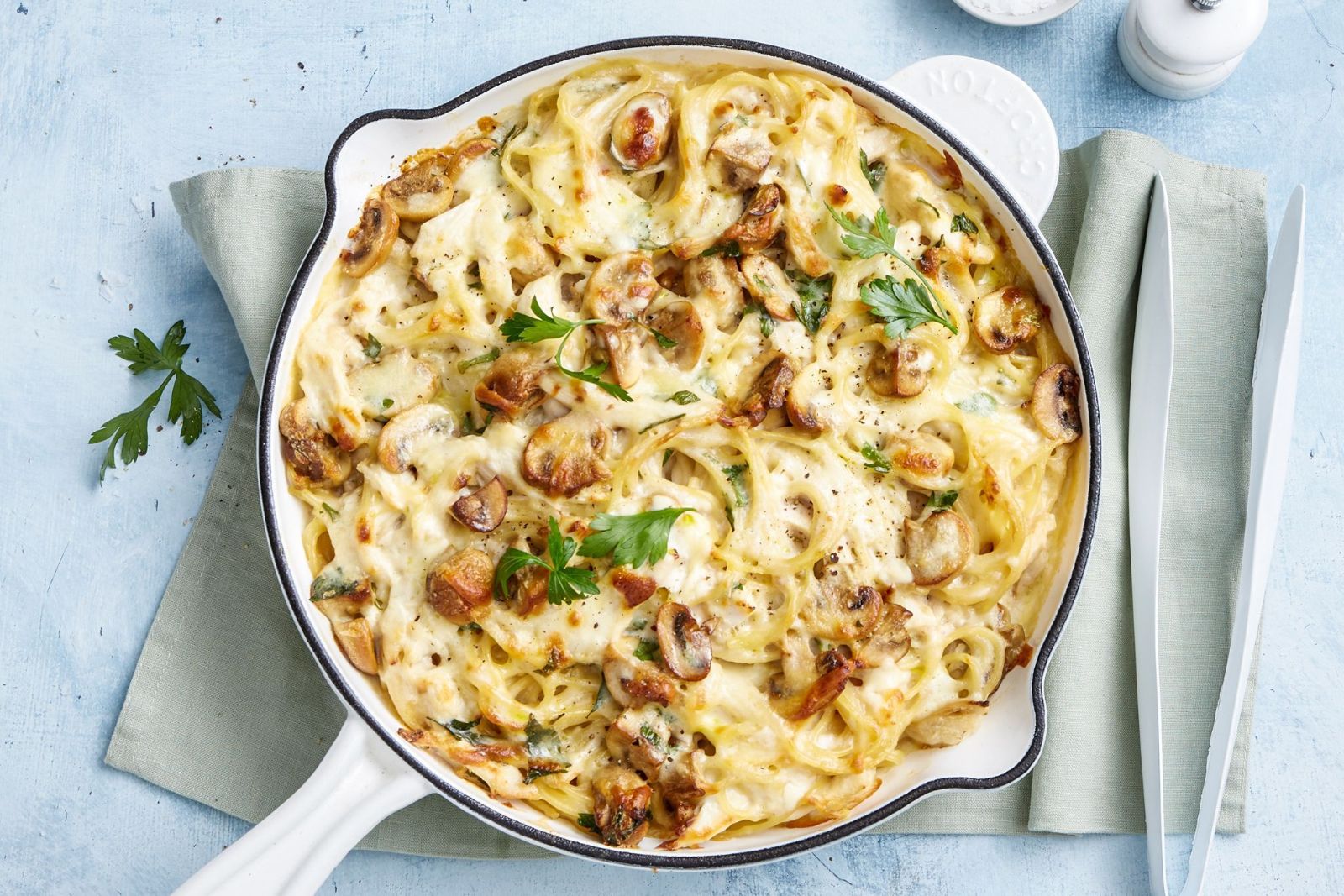
Chicken Tetrazzini, a creamy and comforting pasta dish, is a beloved classic that combines tender chicken, pasta, mushrooms, and a luscious sauce. This flavorful casserole is often baked to perfection, resulting in a hearty and satisfying meal. Whether served as a main course or as a crowd-pleasing dish for gatherings and potlucks, Chicken Tetrazzini never fails to impress. If you have leftovers or want to prepare this delectable dish in advance, freezing is a convenient option. Freezing Chicken Tetrazzini allows you to preserve its flavors and textures, ensuring that you can enjoy this delightful pasta dish whenever you desire, with minimal effort. In this guide, we will explore the steps and techniques for freezing Chicken Tetrazzini, including proper packaging and storage methods, so you can have a ready-to-bake casserole on hand for a delicious and hassle-free meal. Join us as we uncover the secrets of freezing Chicken Tetrazzini and unlock the convenience of having this comforting favorite.
Here are the simple steps to freeze chicken tetrazzini:
- Step 1: Prepare the Chicken Tetrazzini
- Step 2: Portion the Chicken Tetrazzini
- Step 3: Cool the Chicken Tetrazzini
- Step 4: Choose Suitable Freezer Containers
- Step 5: Pack the Chicken Tetrazzini
- Step 6: Seal the Containers or Bags
- Step 7: Label and Date the Packages
- Step 8: Freeze the Chicken Tetrazzini
- Step 9: Thaw and Reheat
Step 1: Prepare the Chicken Tetrazzini
Before you can freeze Chicken Tetrazzini, it’s important to ensure that it is cooked and ready to be preserved. Whether you have made your own Chicken Tetrazzini from scratch or purchased a pre-made version from the store, it should be fully cooked before freezing.
If you have a favorite Chicken Tetrazzini recipe, follow the steps to prepare the dish according to the recipe instructions. This typically involves cooking the chicken, sautéing the mushrooms, preparing the creamy sauce, and combining all the ingredients with pasta. Be sure to cook the dish until it reaches a safe internal temperature to ensure it is fully cooked and safe to consume.
Alternatively, if you prefer a convenient option, you can purchase pre-made Chicken Tetrazzini from the store. These pre-packaged versions are usually fully cooked and ready to be frozen. Simply follow the package instructions for heating the dish before freezing.
Regardless of whether you make it from scratch or buy a pre-made version, it’s essential to have the Chicken Tetrazzini prepared and cooked before moving on to the freezing process. This step ensures that the flavors and textures of the dish are fully developed and will be preserved during freezing.
Step 2: Portion the Chicken Tetrazzini
After preparing the Chicken Tetrazzini, the next step is to divide it into individual or family-sized portions based on your preference. Portioning the Chicken Tetrazzini before freezing allows for convenient thawing and reheating of only the amount you need at a given time, minimizing waste and ensuring optimal freshness.
To begin, consider the serving sizes that work best for you and your household. If you often enjoy Chicken Tetrazzini as a main course, you might opt for individual portions that can be easily thawed and reheated for individual meals. Alternatively, if you plan on serving it to your family or guests, portioning it into larger containers suitable for family-sized servings would be more appropriate.
Use a sharp knife or a serving spoon to divide the Chicken Tetrazzini into the desired portions. Ensure that each portion contains a balanced amount of chicken, mushrooms, pasta, and sauce to maintain the intended flavors and textures of the dish.
By portioning the Chicken Tetrazzini before freezing, you have greater flexibility in selecting the exact quantity you wish to thaw and reheat, without having to defrost the entire batch. This method also helps maintain the quality of the dish by reducing the number of times it needs to be frozen and reheated, which can affect its taste and texture.
Step 3: Cool the Chicken Tetrazzini
After portioning the Chicken Tetrazzini, it is crucial to allow it to cool completely before placing it in the freezer. Cooling the dish before freezing is important for several reasons.
Firstly, placing hot or warm food directly in the freezer can raise the internal temperature of the freezer. This increase in temperature can affect the quality and safety of other frozen items already stored in the freezer, as it may cause them to partially thaw and refreeze, leading to potential texture and flavor changes.
Secondly, rapid cooling helps prevent the growth of bacteria. When food is cooked, it goes through a temperature range where bacteria can multiply rapidly. Allowing the Chicken Tetrazzini to cool at room temperature or in the refrigerator before freezing minimizes the time it spends within this bacterial growth danger zone, reducing the risk of foodborne illnesses.
To cool the Chicken Tetrazzini, you can place the portioned containers or dishes on a cooling rack or trivet. This allows air to circulate around the containers, promoting even cooling. Avoid stacking the containers immediately after portioning, as it can trap heat and slow down the cooling process.
By allowing the Chicken Tetrazzini to cool completely before freezing, you ensure the quality and safety of the dish as well as the other items in your freezer. It helps maintain the texture, flavor, and overall integrity of the Chicken Tetrazzini, resulting in a more enjoyable dining experience when you decide to thaw and reheat it.
Step 4: Choose Suitable Freezer Containers
When freezing Chicken Tetrazzini, it is important to select appropriate freezer containers or resealable plastic bags. The containers or bags you choose should be freezer-safe, sturdy, and capable of preventing freezer burn. Additionally, they should be clean and dry to ensure the quality and freshness of the Chicken Tetrazzini during freezing.
Freezer burn occurs when food is exposed to air and moisture in the freezer, resulting in dehydration and oxidation. To prevent freezer burn and maintain the taste and texture of the Chicken Tetrazzini, follow these guidelines when choosing freezer containers:
- Freezer-safe: Ensure that the containers or bags you use are specifically labeled as freezer-safe. Regular storage containers or bags may not be designed to withstand the low temperatures of the freezer, leading to cracks or breakage.
- Sturdy and leak-proof: Select containers that are sturdy and have secure lids or bags that can be tightly sealed. This helps prevent air and moisture from entering the packaging, preserving the quality of the Chicken Tetrazzini.
- Size and shape: Consider the portion sizes you have prepared and choose containers or bags that can accommodate the individual or family-sized portions. It’s generally advisable to leave some headspace in the containers or bags to allow for expansion during freezing.
- Transparent or labeled: Opt for transparent containers or bags, or use labels to clearly identify the contents. This will make it easier to locate and select specific portions of Chicken Tetrazzini from the freezer when needed.
By choosing suitable freezer containers or bags, you can effectively protect the Chicken Tetrazzini from freezer burn and maintain its quality throughout the freezing process. This ensures that when you’re ready to thaw and reheat the dish, it will taste just as delicious as when it was freshly made.
Step 5: Pack the Chicken Tetrazzini
After choosing suitable freezer containers or bags, the next step is to pack the cooled Chicken Tetrazzini into them. It’s important to handle the packing process with care to maintain the quality and integrity of the dish during freezing.
Here’s how to pack the Chicken Tetrazzini effectively:
- Cooled Chicken Tetrazzini: Ensure that the Chicken Tetrazzini has completely cooled down before packing it. This prevents condensation from forming inside the containers or bags, which could lead to freezer burn.
- Leave headspace: Leave some headspace at the top of the containers or bags. During freezing, liquids expand, and having extra space allows for this expansion without causing the containers or bags to burst. As a general guideline, leave about 1/2 to 1 inch of headspace to accommodate the expansion.
- Evenly distribute: Distribute the Chicken Tetrazzini evenly within the containers or bags. This helps promote even freezing and thawing later on. If using bags, try to lay them flat and spread the Chicken Tetrazzini out in a single layer. For containers, avoid overcrowding by not filling them to the brim.
- Remove air: If using resealable bags, gently press out any excess air before sealing them. This reduces the amount of air trapped inside, minimizing the risk of freezer burn. For containers, ensure that the lids are securely fastened to create an airtight seal.
- Seal properly: Ensure that the containers or bags are tightly sealed to prevent air and moisture from entering. This helps maintain the quality and freshness of the Chicken Tetrazzini during freezing.
By carefully packing the Chicken Tetrazzini into the containers or bags, leaving some headspace, and avoiding overcrowding, you create an environment that promotes even freezing and easier thawing later on. Proper packing helps preserve the flavors, textures, and overall quality of the Chicken Tetrazzini, ensuring that it tastes delicious when you’re ready to enjoy it after freezing.
Step 6: Seal the Containers or Bags
In order to maintain the optimal quality of the Chicken Tetrazzini during freezing, it is crucial to ensure a tight seal on the containers or bags. This step helps prevent air and moisture from entering the packaging, which can lead to freezer burn and negatively impact the taste and texture of the dish.
Here’s how to effectively seal the containers or bags:
- Containers with lids: If you are using containers with lids, make sure they are securely fastened. Press down firmly on the lids to create a tight seal. Check for any gaps or openings and adjust the lids if necessary. Ensure that all edges are properly aligned to prevent air from seeping in.
- Resealable plastic bags: If you are using resealable plastic bags, carefully close the bags by squeezing out excess air before sealing them. Start from the bottom of the bag, pressing the air towards the opening as you seal it. Use your fingers to slide along the seal, ensuring it is tightly closed and airtight.
- Double-sealing for extra protection: For added assurance, consider double-sealing the containers or bags. This can be done by using an additional layer of plastic wrap or placing the filled container or bag inside a second one. Double-sealing provides an extra barrier against air and moisture, reducing the risk of freezer burn.
By ensuring a tight seal on the containers or bags, you create a protective barrier that helps prevent air and moisture from entering the packaging. This minimizes the chances of freezer burn, which can affect the taste and texture of the Chicken Tetrazzini. A proper seal helps to preserve the flavors and quality of the dish, ensuring a delicious dining experience when you decide to thaw and reheat it.
Step 7: Label and Date the Packages
After sealing the containers or bags containing the Chicken Tetrazzini, it is essential to label and date each package. This simple yet crucial step helps you keep track of the contents and the date of freezing, allowing you to prioritize consumption based on freshness and maintain an organized freezer.
Here’s why labeling and dating the packages is important:
- Identification of contents: By labeling each package, you can easily identify the Chicken Tetrazzini in the freezer. This is particularly helpful when you have multiple frozen dishes or ingredients stored. A clear label prevents confusion and saves you time when searching for a specific item.
- Date of freezing: Adding the date of freezing allows you to keep track of how long the Chicken Tetrazzini has been in the freezer. This information is vital for maintaining food safety and quality. It helps you prioritize consumption based on the recommended freezer storage time for cooked dishes.
- FIFO (First-In, First-Out): Labeling and dating the packages enable you to follow the FIFO method. This means using the oldest frozen Chicken Tetrazzini first, ensuring that none of the portions get forgotten and left in the freezer for an extended period. It promotes proper rotation and minimizes the risk of food waste.
- To label the packages effectively, use a marker or labels that adhere well to the containers or bags. Clearly write the name “Chicken Tetrazzini” on each label to identify the dish. Below that, write the date of freezing in a format that is easy to understand, such as “MM/DD/YYYY.”
By labeling and dating the packages, you can easily identify and track the Chicken Tetrazzini in your freezer, prioritize consumption based on freshness, and ensure that none of the portions are forgotten or wasted. This simple step contributes to an organized freezer and helps you make the most of your frozen Chicken Tetrazzini.
Step 8: Freeze the Chicken Tetrazzini
After properly labeling and dating the packages, the next step is to place the sealed containers or bags of Chicken Tetrazzini in the freezer. This step ensures that the dish freezes thoroughly and maintains its quality during storage.
Here’s how to freeze the Chicken Tetrazzini effectively:
- Single layer: Arrange the sealed containers or bags in a single layer initially. This allows for better air circulation around each package, promoting even and efficient freezing. Placing them in a single layer also helps prevent the portions from sticking together.
- Freezer placement: Put the Chicken Tetrazzini packages in an area of the freezer that maintains a consistently cold temperature. Ideally, this should be the coldest part of the freezer, such as the back or bottom shelves. Avoid placing them near the freezer door, as it may expose them to temperature fluctuations when the door is opened.
- Complete freezing: Ensure that the Chicken Tetrazzini portions are completely frozen before stacking them. This typically takes several hours or overnight, depending on the size and thickness of the portions. Freezing the portions individually first allows for faster and more efficient freezing.
- Stack for space-saving: Once the Chicken Tetrazzini portions are frozen solid, you can stack them in the freezer to save space. However, make sure that they are properly sealed and sturdy to prevent any damage or crushing. You can stack similar-sized containers or bags on top of each other, keeping the oldest ones on top for FIFO organization.
By placing the sealed containers or bags of Chicken Tetrazzini in the freezer, arranging them in a single layer until completely frozen, and then stacking them, you create an efficient and organized storage system. Proper freezing ensures that the Chicken Tetrazzini retains its flavor, texture, and overall quality for an extended period.
How long can chicken tetrazzini last in the freezer?
Chicken Tetrazzini can last in the freezer for up to 2-3 months. When properly stored at 0°F (-18°C) or below, it can maintain its quality within this timeframe. Beyond that, while it may still be safe to consume, the taste and texture may deteriorate.
Step 9: Thaw and Reheat
Once you’re ready to enjoy the frozen Chicken Tetrazzini, it’s important to thaw it properly and reheat it safely. This step ensures that the dish is heated thoroughly, eliminating any potential bacterial growth and maintaining its taste and texture.
Here’s how to thaw and reheat the frozen Chicken Tetrazzini:
- Thawing in the refrigerator: Transfer the desired portion of frozen Chicken Tetrazzini from the freezer to the refrigerator. Allow it to thaw overnight or for several hours until completely thawed. Thawing in the refrigerator is the safest method, as it maintains a controlled and consistent temperature, minimizing the risk of bacterial growth.
- Reheating options: Once the Chicken Tetrazzini is thawed, you have various options for reheating it. The most common methods include using the microwave, oven, or stovetop.
Choose the method that suits your preference and convenience.
- Microwave:
Place a portion of thawed Chicken Tetrazzini in a microwave-safe dish and heat it in the microwave. Heat in intervals, stirring occasionally to ensure even heating. Follow the microwave’s instructions for the appropriate power level and time to reheat the dish thoroughly.
- Oven:
Preheat the oven to a moderate temperature (around 350°F or 175°C). Transfer the portion of thawed Chicken Tetrazzini to an oven-safe dish and cover it with foil to prevent drying out. Bake for around 20-30 minutes or until heated through, stirring occasionally if needed.
- Stovetop:
Place a portion of thawed Chicken Tetrazzini in a saucepan or skillet. Heat over medium-low heat, stirring occasionally to prevent sticking or burning. Heat until the dish is thoroughly heated and reaches a safe internal temperature.
By thawing and reheating the frozen Chicken Tetrazzini, you can ensure that it is safely heated, maintaining its taste, texture, and quality. Remember to handle the thawed and reheated portions properly, refrigerating any leftovers promptly to maintain food safety.
Other related questions
Can you refreeze chicken tetrazzini?
It is generally not recommended to refreeze Chicken Tetrazzini once it has been thawed. Refreezing can lead to a loss in quality, including changes in texture and taste. Additionally, each thawing and refreezing cycle increases the risk of bacterial growth and foodborne illnesses. It is best to consume the Chicken Tetrazzini after the initial thawing to ensure optimal safety and quality.
How do I know if the chicken tetrazzini has gone bad after being frozen?
To determine if frozen Chicken Tetrazzini has gone bad, check for signs of spoilage such as an off smell, unusual texture, or discoloration. If the dish exhibits a sour or rancid odor, a slimy or mushy texture, or significant changes in color, it may indicate bacterial growth or freezer burn. It is important to prioritize food safety and discard any Chicken Tetrazzini that appears spoiled or has been stored in the freezer for an extended period beyond recommended storage times.
Can you freeze raw chicken tetrazzini?
No, it is not recommended to freeze raw chicken tetrazzini. Freezing raw chicken tetrazzini can lead to issues with food safety and texture. Raw ingredients like uncooked chicken, uncooked pasta, and uncooked vegetables may not freeze and thaw well, resulting in a less desirable texture and potentially compromising food safety. It is best to cook the chicken tetrazzini before freezing for better results.
Are there any special considerations for freezing creamy or cheesy chicken tetrazzini?
Yes, there are special considerations for freezing creamy or cheesy chicken tetrazzini. Cream-based and cheesy sauces can sometimes undergo texture changes when frozen and thawed, potentially resulting in a grainy or separated consistency. To minimize this, you can slightly undercook the pasta and sauce before freezing to help retain some firmness.
Can I freeze chicken tetrazzini with different pasta or sauces?
Yes, you can freeze chicken tetrazzini with different types of pasta or sauces. However, it’s important to keep in mind that different types of pasta may have varying textures after freezing and thawing. Some pasta varieties hold up better in terms of texture when frozen, such as penne or rigatoni, compared to delicate noodles like angel hair or fettuccine. Similarly, different sauces may behave differently upon freezing and thawing, with cream-based sauces or cheesy sauces potentially undergoing slight texture changes.








